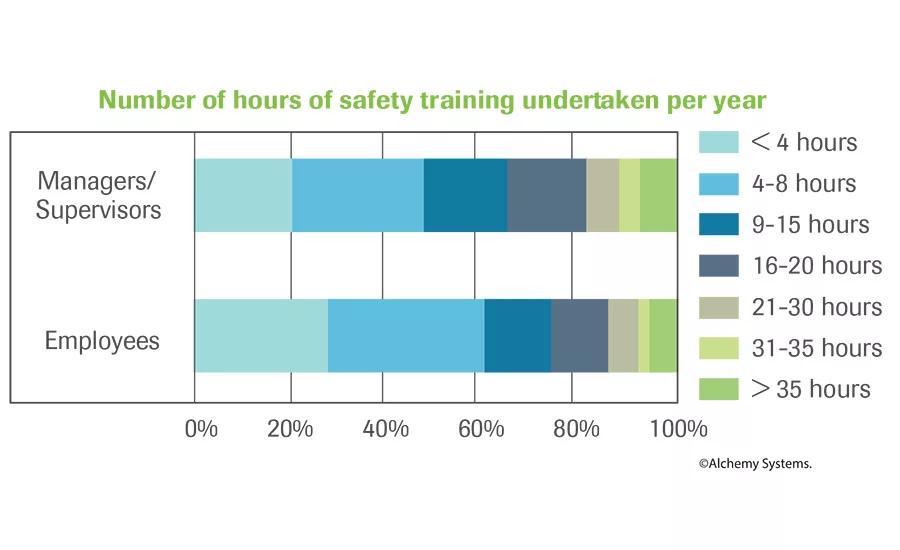Manufacturing News
Where the gaps lie in food safety training
Many food companies aren't getting all they can out of their food safety training efforts

Companies are devoting significant time to food safety training. About 74 percent of employees get four or more hours of training per year. For supervisors/managers, 52 percent get nine or more hours of training per year. Source: Alchemy Systems.
Almost all food and beverage companies are committed to food safety training, but many are not getting all they could out of their training efforts. Why? A study from Alchemy Systems in partnership with Campden, BRI, SQF Institute, BRC, SGS and TSI polled thousands of food and beverage processors in seeking the answer to this question. The study, entitled “Closing the Gaps in Food Safety Training: Results from the Global Food Safety Training Survey,” found that while 88 percent of processors surveyed said their senior management provides the needed food safety training, 75 percent of respondents felt that employees would be more productive if their food safety program was more consistently applied.
But the problem is more pervasive. Despite the good news on management commitment to food safety investments in training, 62 percent of survey respondents indicated that despite their efforts in classroom training, there still were employees not following food safety programs on the plant floor. The survey and other research suggest several reasons that contribute to noncompliance:
- Training is too complex for workers to understand.
- Training is not engaging, especially for Millennials.
- Food safety is not a shared responsibility and is only focused on managers to the detriment of supervisors and frontline workers.
- Food safety training is not consistently reinforced.
- Employee behaviors are not assessed on the plant floor to verify knowledge and application.
Classroom training is often too complex or doesn’t connect with a worker’s learning style. Compounding this is that training materials are often unsuitable for a highly diverse workforce speaking multiple languages with varying degrees of education.
But food safety is not the only training that a worker receives; there is safety and equipment training vying for a worker’s busy schedule. “Harmonizing training is an important opportunity for food companies,” says Laura Dunn Nelson, vice president, business development, Alchemy Systems. “The survey data notes that QA/QC personnel are largely responsible for the food safety training while operational and EHS training is typically led by human resources, operations or risk management departments. Because of this fragmentation, these departments compete for the limited employee training time available and are not always able to provide the needed employee training.” On the other side of the coin, the employee is bombarded with protocols, procedures and requirements without a clear emphasis on priorities, adds Nelson.
Another issue, the study points out, is that food safety training is primarily delivered during the new staff orientation process. For both new hires and experienced workers who are already overwhelmed with new information, absorbing more is not likely to happen. Another overlooked—but equally important issue—is the training of non-staff, contract or temporary employees—or workers at a co-processing facility. A food safety mistake by any of these workers can just as easily upset a brand as a mistake from in-house, full-time employees. The study says that 44 percent of food companies are creating an exposure by not mandating the same training for their contract or temporary workers. “Many companies are working directly with staffing agencies by providing the company’s on-boarding training for implementation by the staffing agency to help integrate and speed up the process,” says Nelson.
According to the study, half of processors have two to four audits per year, and 31 percent have more than five audits per year. The audits reveal several key gaps in food safety training programs. Lack of refresher classes is the top training-related audit deficiency. In addition, the study points out that while employees have had classroom training on sanitation, HACCP, personal hygiene, GMPs and allergens, processors are not verifying that the training has been effective on the plant floor.
FE conducted an exclusive interview with Alchemy Systems’ Laura Dunn Nelson about the study and covered some additional concerns about food safety training. To read the entire interview, click here.
Looking for a reprint of this article?
From high-res PDFs to custom plaques, order your copy today!







